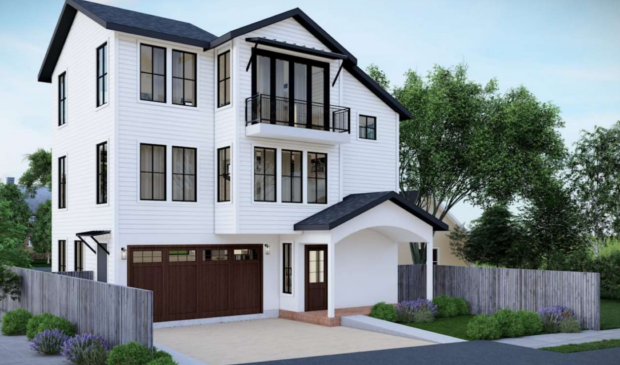Photo by city of Austin. Rendering of the proposed ADU
Appeal reveals ‘urgent need’ to review historic standards
Wednesday, September 4, 2024 by
Elizabeth Pagano A final attempt to stop the construction of a large second home in the Robertson/Stuart & Mair Historic District failed at City Council last week, despite concerns that its approval could set a worrying precedent for local historic districts citywide. The home is planned in the neighborhood roughly between the French Legation and the Texas State Cemetery.
Neighbors appealed the Historic Landmark Commission decision to issue a certificate of appropriateness for a new accessory dwelling unit (ADU) behind the historic home at 1107 E. 10th St. They claim that the commission did not correctly apply the district’s historic design standards and say that the planned structure does not fit with the historic character of the neighborhood. Their appeal was struck down by the Planning Commission last month before moving to City Council.
In testimony from the appellants and their supporters, it became clear that they believed the current application of the HOME Ordinance in local historic districts was an issue, even though the HOME Ordinance does not take precedence over the design standards of historic districts.
The problem, explained Preservation Austin Executive Director Lindsey Derrington, is that because the local historic districts and citywide historic design standards were established with McMansion rules in place, they assume those rules are still in place and will be followed.
“None of this applies today, making these standards woefully out of date. We will continue to see contentious projects until they’re updated,” she said. “We hope that together we can all resolve these larger structural issues to better protect our heritage.”
Though historic zoning still provides demolition protections in local historic districts and includes a preservation bonus that supports historic zoning, Derrington said there was an “urgent need” to address the other issues and asked Council to take immediate action to update Austin’s Historic Design Standards. She also encouraged neighborhoods to update their own design standards to be more specific where they can, suggesting the city require more representative renderings of new construction in the meantime.
Appellants in the case stressed that they did not object to the HOME Ordinance per se, but did ask for a chance to review the case – and their design standards – under the new law of the land.
Appellant Mark Rogers noted that the new ADU would be the only three-story residence in the historic district, and that 79 percent of the buildings in the district are one story. The revised plans for the ADU more than doubled its size – from 1,100 square feet to 2,600 square feet. And though the height of the project did not change, its bulk, which was previously mitigated by compatibility standards that are no longer in place, has changed considerably.
“You passed HOME. You had the courage to pass HOME. And you had the wisdom to include within HOME a provision to protect our historic landmarks within districts,” Rogers said. “Let’s get this landmark-setting case right.”
In his testimony, property owner Matt Jordan stressed that his plan preserved the historic home at the front of the property, which is the primary goal of the historic district. He noted that the vast majority of the design standards for the district were about protecting historic structures and included only one line about the height of proposed new construction.
“I really don’t understand what the appellants mean when they say that HOME has impacted this. Because HOME has impacted the width, but HOME has not overstepped the design standards they say it has,” he said.
Jordan told Council that, over the past two years, he has attended 11 meetings to get an approval for his plans (though the first six meetings were for the more modest 1,100-square-foot ADU) and worked extensively with the city’s Architectural Review Committee to develop the plans. He said that he had tried to limit the number of windows facing his neighbor and step back some of its mass to lessen its impact. In addition, he maintains that the new home will be minimally visible from 10th Street because of the depth of the property, which he said “was a major consideration” for the Historic Landmark Commission.
In her rebuttal, appellant Tristana Rogers questioned his stance, saying, “If HOME doesn’t have anything to do with this, why did he change his design? … I think he’s just full of malarkey and just trying to press this to have the biggest thing he can have and destroy the character of our neighborhood.”
Mayor Pro Tem Leslie Pool said she was “troubled” by the case saying, “it seems clear that some of the design standards for the Robertson/Stuart & Mair Historic District weren’t strictly followed here.” However, she said it wasn’t clear that its return to the Historic Landmark Commission for further deliberation would yield a different result.
Pool said she was also concerned that the case had been linked to the HOME initiative, even though Council had explicitly ordered that historic design standards take precedence over other development entitlements, like the ones provided through the HOME Ordinance. In an aside to the city manager, Pool said that it might be beneficial to have commissioners briefed on the new ordinances and how they interact with existing code.
“Design standards for historic districts already apply, no matter the underlying zoning. We didn’t change that,” Pool said. “A shared understanding sure would have been helpful to all of us.”
There was no further discussion by City Council and no motion or vote, which means the appeal by neighbors was denied.
The Austin Monitor’s work is made possible by donations from the community. Though our reporting covers donors from time to time, we are careful to keep business and editorial efforts separate while maintaining transparency. A complete list of donors is available here, and our code of ethics is explained here.
You're a community leader
And we’re honored you look to us for serious, in-depth news. You know a strong community needs local and dedicated watchdog reporting. We’re here for you and that won’t change. Now will you take the powerful next step and support our nonprofit news organization?







